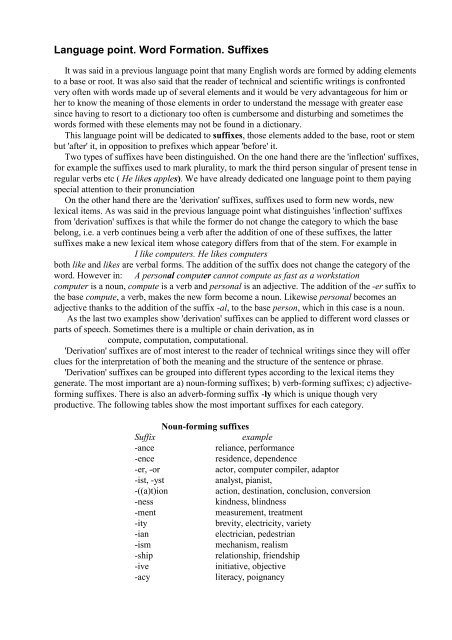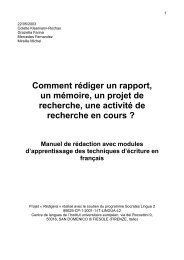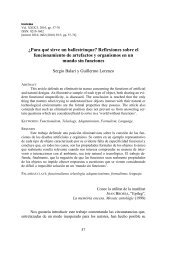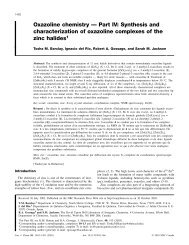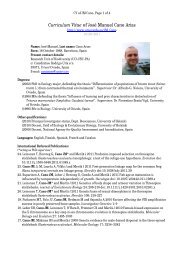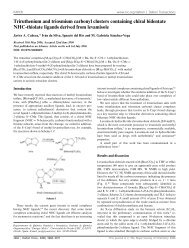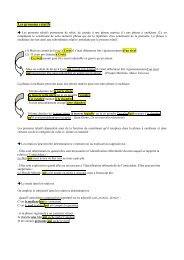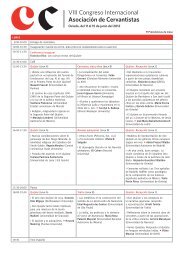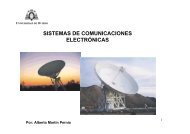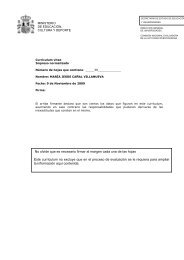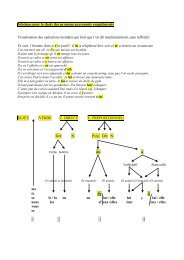Language point. Word Formation. Suffixes
Language point. Word Formation. Suffixes
Language point. Word Formation. Suffixes
Create successful ePaper yourself
Turn your PDF publications into a flip-book with our unique Google optimized e-Paper software.
<strong>Language</strong> <strong>point</strong>. <strong>Word</strong> <strong>Formation</strong>. <strong>Suffixes</strong><br />
It was said in a previous language <strong>point</strong> that many English words are formed by adding elements<br />
to a base or root. It was also said that the reader of technical and scientific writings is confronted<br />
very often with words made up of several elements and it would be very advantageous for him or<br />
her to know the meaning of those elements in order to understand the message with greater ease<br />
since having to resort to a dictionary too often is cumbersome and disturbing and sometimes the<br />
words formed with these elements may not be found in a dictionary.<br />
This language <strong>point</strong> will be dedicated to suffixes, those elements added to the base, root or stem<br />
but 'after' it, in opposition to prefixes which appear 'before' it.<br />
Two types of suffixes have been distinguished. On the one hand there are the 'inflection' suffixes,<br />
for example the suffixes used to mark plurality, to mark the third person singular of present tense in<br />
regular verbs etc ( He likes apples). We have already dedicated one language <strong>point</strong> to them paying<br />
special attention to their pronunciation<br />
On the other hand there are the 'derivation' suffixes, suffixes used to form new words, new<br />
lexical items. As was said in the previous language <strong>point</strong> what distinguishes 'inflection' suffixes<br />
from 'derivation' suffixes is that while the former do not change the category to which the base<br />
belong, i.e. a verb continues being a verb after the addition of one of these suffixes, the latter<br />
suffixes make a new lexical item whose category differs from that of the stem. For example in<br />
I like computers. He likes computers<br />
both like and likes are verbal forms. The addition of the suffix does not change the category of the<br />
word. However in: A personal computer cannot compute as fast as a workstation<br />
computer is a noun, compute is a verb and personal is an adjective. The addition of the -er suffix to<br />
the base compute, a verb, makes the new form become a noun. Likewise personal becomes an<br />
adjective thanks to the addition of the suffix -al, to the base person, which in this case is a noun.<br />
As the last two examples show 'derivation' suffixes can be applied to different word classes or<br />
parts of speech. Sometimes there is a multiple or chain derivation, as in<br />
compute, computation, computational.<br />
'Derivation' suffixes are of most interest to the reader of technical writings since they will offer<br />
clues for the interpretation of both the meaning and the structure of the sentence or phrase.<br />
'Derivation' suffixes can be grouped into different types according to the lexical items they<br />
generate. The most important are a) noun-forming suffixes; b) verb-forming suffixes; c) adjectiveforming<br />
suffixes. There is also an adverb-forming suffix -ly which is unique though very<br />
productive. The following tables show the most important suffixes for each category.<br />
Noun-forming suffixes<br />
Suffix<br />
example<br />
-ance<br />
reliance, performance<br />
-ence<br />
residence, dependence<br />
-er, -or<br />
actor, computer compiler, adaptor<br />
-ist, -yst<br />
analyst, pianist,<br />
-((a)t)ion<br />
action, destination, conclusion, conversion<br />
-ness<br />
kindness, blindness<br />
-ment<br />
measurement, treatment<br />
-ity<br />
brevity, electricity, variety<br />
-ian<br />
electrician, pedestrian<br />
-ism<br />
mechanism, realism<br />
-ship<br />
relationship, friendship<br />
-ive<br />
initiative, objective<br />
-acy<br />
literacy, poignancy
Adjective-forming suffixes<br />
suffix<br />
example<br />
-able<br />
comfortable, loadable, available<br />
-ible<br />
possible, compatible, feasible<br />
-(ic)al<br />
magnetic, electric, electrical<br />
-(i)ous<br />
previous, dangerous<br />
-ful<br />
careful, helpful<br />
-less<br />
careless, helpless,<br />
-ish<br />
redish, Polish, English<br />
-ate<br />
articulate, confederate<br />
-ary<br />
elementary, binary, secondary<br />
-ive<br />
generative, productive, objective<br />
-y worthy, fuzzy<br />
Verb-forming suffixes<br />
suffix<br />
-ate<br />
-en<br />
-fy<br />
-ize<br />
-ish<br />
example<br />
calculate, create, activate<br />
worsen, harden<br />
simplify, unify, deify<br />
realize, computerize<br />
accomplish, finish, polish<br />
Note that some suffixes are found in more than one group. For instance articulate which can be<br />
both adjective and verb. However its pronunciation will be different, the adjective form is<br />
pronounced [-it] while the verb form is pronounced [-eit].<br />
Note also that there are many words which have endings identical with suffixes that are not<br />
suffixes. <strong>Suffixes</strong> are just helpful hints to a better understanding of texts.<br />
There are two suffixes, -ing and -ed, that need special treatment. These two suffixes are found in<br />
both inflectional and derivational suffixes, and their verbal character is most often present. Both<br />
suffixes are adjective-forming suffixes and the -ing suffix is also used in the formation of nouns.<br />
For example programming is a noun in 1 but an adjective in 2<br />
1.- Successful programming requires that a task be broken down into methodical steps<br />
2.- There are several programming languages in use nowadays.<br />
Note that apart from form, and word-formation is about form, there is function. Form many<br />
times helps us in determining function but this is not always the case. What matters is function.<br />
Many times we find a noun form which functions as an adjunct, which is the characteristic function<br />
of adjectives. For example in<br />
Computer peripherals are getting better.<br />
computer is formally a noun, however here it functions as an adjunct, it takes the function of<br />
adjectives.
Task 1<br />
Underline the 'derivation' suffixes found in the sentences below. Find out what parts of speech<br />
the words with the underlined suffixes belong to.<br />
1.- The 1980s witnessed the introduction and widespread use of personal computers at all levels<br />
of schooling<br />
2.- The number of computers used in U.S. elementary and secondary schools increased<br />
3.- Some critics see computer education as merely the latest in a series of unsuccessful attempts<br />
to revolutionize education through the use of audio- and visually-oriented nonprint media.<br />
4.- For example, motion pictures, broadcast television, filmstrips, audio recorders, and<br />
videotapes were all initially heralded for their instructional potential, but each of these<br />
ultimately became minor classroom tools alongside conventional methods.<br />
5.- A majority of students now use computers and COMPUTER SOFTWARE sometime during<br />
the school year--either to learn about computers or as a tool for learning other subjects<br />
6.- Computer educators feel the number of computers in the schools is still not high enough to<br />
affect classroom learning as much as books and classroom conversation do.<br />
7.- Supporters believe, however, that computers are a much more powerful learning medium than<br />
the others that preceded it<br />
8.- They cite the essential interactive nature of using computers programmed to provoke decision<br />
making and manipulations of visual environments<br />
9.- Learning tasks can become more individualized, enabling each student to receive immediate<br />
feedback.<br />
10.- Some experts say that having students work collaboratively on computers leads to greater<br />
initiative and more autonomous learning<br />
11.- COMPUTER-AIDED DESIGN (CAD) systems have replaced drafting boards in thousands<br />
of engineering and architectural firms<br />
12.- Cartographers, seismologists, geologists, astronomers, and chemists are also heavy users of<br />
graphic-oriented computer systems..<br />
Task 2<br />
Do the same as in task 1 with the following paragraph. Find out also other compound wordforms.<br />
The other major computer-based activity is computer-assisted instruction, or CAI. CAI programs are<br />
specifically written for teaching individual students in school settings. They present students with a<br />
question and compare the student's answer with the single correct answer. Typically, the program<br />
responds to a correct answer with praise and to wrong answers with an explanation and another, similar<br />
problem. Sometimes CAI programs are embedded in a gamelike context, and most provide audio and<br />
video embellishments. Some programs collect patterns of students' responses and provide reports to<br />
teachers. Most CAI programs cover limited material, but some large-scale, multiyear reading and<br />
mathematics curricula have been developed.<br />
Studies of the effects of CAI on how well children learn basic skills have generally been supportive of<br />
CAI, although critics question the quality of much of the research. They claim that CAI's effects may be<br />
mainly limited to the early grades, to more routine skills, to students from disadvantaged backgrounds,<br />
and, most impressively so far, among learning disabled students. Yet many computer education<br />
enthusiasts believe that computers can be used in more innovative ways; they see CAI as a substitute for<br />
paper and pencil drills and thus, as a weak use of computers.<br />
Yet there are good reasons for the dominance of CAI. Its activities are relatively easy to program; it is<br />
compatible with traditional methods of instruction; and it requires relatively little effort to organize<br />
computer use.


